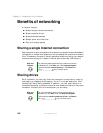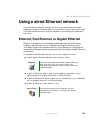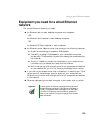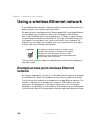
164
Chapter 11: Networking Your Computer
www.gateway.com
Using a wireless Ethernet network
A wireless Ethernet network is ideal for creating a home or office network or
adding mobility to an existing wired Ethernet.
Wireless Ethernet is available at two different speeds. 802.11a wireless Ethernet
runs at speeds up to 54 Mbps, or about half the speed of Fast Ethernet.
802.11b/g wireless Ethernet runs at speeds up to 11 Mbps, or approximately
the same speed as standard wired Ethernet. This type of network allows you
the freedom to move about your home or office with your notebook. For
example, you can take your notebook from your home office to your patio
without having an Ethernet jack available.
The two most common types of wireless Ethernet networks are access point
and peer-to-peer.
Example access point wireless Ethernet
network
By using an access point, you can join a wireless Ethernet network and access
a wired Ethernet network. An access point also lets you access the Internet.
The following is an example of an access point wireless Ethernet network. The
network is made up of an access point, a cable or DSL modem, and your
computers. The access point is the central control point for the network.
Attached to the access point is the cable or DSL modem that provides access
to the Internet. Each of the computers or Ethernet-ready devices communicate
Important The speed of a wireless network is related to signal
strength. Signal strength is affected by the distance
between your wireless network devices, by radio
interference, and by interference from natural obstructions
such as walls, floors, and doors.


















